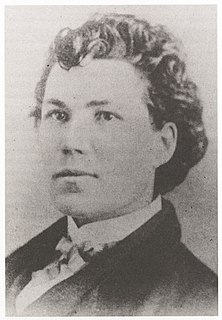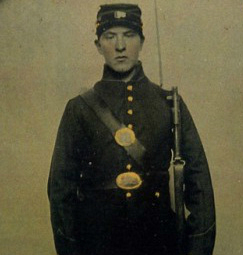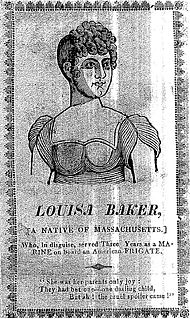
Sarah Emma Edmonds, was a Canadian-born woman who is known for serving as a man with the Union Army during the American Civil War. In 1992, she was inducted into the Michigan Women's Hall of Fame.

Loreta Janeta Velázquez, was a Cuban-born woman who masqueraded as a male Confederate soldier during the American Civil War. After her soldier husband's accidental death, she enlisted in the Confederate States Army in 1861. She then fought at Bull Run, Ball's Bluff, and Fort Donelson, but was discharged when her gender was discovered while in New Orleans. Undeterred, she reenlisted and fought at Shiloh, until unmasked once more. She then became a Confederate spy, working in both male and female guises, and as a double agent also reporting to the U.S. Secret Service. She remarried three more times, being widowed in each instance. According to William C. Davis, she died in January 1923 under the name Loretta J. Beard after many years away from the public eye in a public psychiatric facility, St. Elizabeths Hospital. She spied on the Union for about 5 years.

Cross-dressing in motion pictures began in the early days of the silent films. Charlie Chaplin and Stan Laurel brought the tradition of female impersonation in the English music halls when they came to America with Fred Karno's comedy troupe in 1910. Both Chaplin and Laurel occasionally dressed as women in their films. Even the beefy American actor Wallace Beery appeared in a series of silent films as a Swedish woman. The Three Stooges, especially Curly, sometimes appeared in drag in their short films. The tradition has continued for many years, usually played for laughs. Only in recent decades have there been dramatic films in which cross-dressing was included, possibly because of strict censorship of American films until the mid-1960s. One early exception was the murderer, a transvestite who wears particularly frilly dresses and petticoats, in Alfred Hitchcock's thriller Murder!. Cross-gender acting, on the other hand, refers to actors or actresses portraying a character of the opposite gender.

Frances Louisa Clayton, also recorded as Frances Clalin, was an American woman who disguised herself as a man to fight for the Union Army in the American Civil War. Under the alias Jack Williams, she enlisted in a Missouri regiment along with her husband, and fought in several battles. She left the army soon after her husband died at Stones River.
Active warfare throughout history has mainly been a matter for men, but women have also played a role, often a leading one. While women rulers conducting warfare was common, women who participated in active warfare were rare. The following list of prominent women in war and their exploits from about 1500 AD up to about 1700 AD.
Active warfare throughout recorded history has predominantly involved male combatants; however, women have also contributed to military activities including as combatants. The following list describes women known to have participated in military actions in the 18th century. For women in warfare in the United States at this time, please see Timeline of women in war in the United States, Pre-1945.

Women in World War I were mobilized in unprecedented numbers on all sides. The vast majority of these women were drafted into the civilian work force to replace conscripted men or work in greatly expanded munitions factories. Thousands served in the military in support roles, e.g. as nurses, but in Russia some saw combat as well.

Brita Christina Hagberg, née Nilsdotter, alias Petter Hagberg,, was a woman who served as a soldier in the Swedish army during the Russo-Swedish War (1788–1790). She is one of two confirmed women to have been decorated for bravery in battle in Sweden before women were allowed into the military in the 20th century.

Sarah Rosetta Wakeman was a woman who served in the Union Army during the American Civil War under the male name of Lyons Wakeman. Wakeman served with Company H, 153rd New York Volunteer Infantry. Her letters written during her service remained unread for nearly a century because they were stored in the attic of her relatives.
During the American Civil War, sexual behavior and attitudes, like many other aspects of life, were affected by the conflict. The advent of photography and easier media distribution, for example, allowed for greater access to sexual material for the common soldier.

Cross-dressing as a literary motif is well attested in older literature but is becoming increasingly popular in modern literature as well. It is often associated with character nonconformity and sexuality rather than gender identity.
Mulan Jr. is a one-act stage musical based on the 1998 Disney animated film Mulan, which in turn was based on the Chinese legend of Hua Mulan and the story "Fa Mulan" by Robert D. San Souci. The adaptation mixes songs featured in the 1998 film as well as deleted songs from the film, including the revival of songs written by Stephen Schwartz, who was the original composer for the 1998 film before leaving to work on The Prince of Egypt. The musical is G-rated, any mature content from the sources it is based on having been deleted in the adaptation. The cast includes 26 roles plus an ensemble.
This article details the history of cross-dressing, the act of wearing the clothes of the sex or gender one does not identify with.

The Female Marine, or The Adventures of Lucy Brewer, was first published in 1815 as a series of pamphlets sold in Boston. The series is the supposedly autobiographical account of Lucy Brewer, although controversy has surrounded the true authorship of the story as some believe it was in fact written by Nathaniel Hill Wright.
Charlotte Hatfield, also known as Charley Hatfield or "Mountain Charley", was a female soldier for the Union Army during the American Civil War.
This is a timeline of women in warfare in the United States up until the end of World War II. It encompasses the colonial era and indigenous peoples, as well as the entire geographical modern United States, even though some of the areas mentioned were not incorporated into the United States during the time periods that they were mentioned.
This is a list of works on the subject of wartime cross-dressing.


















